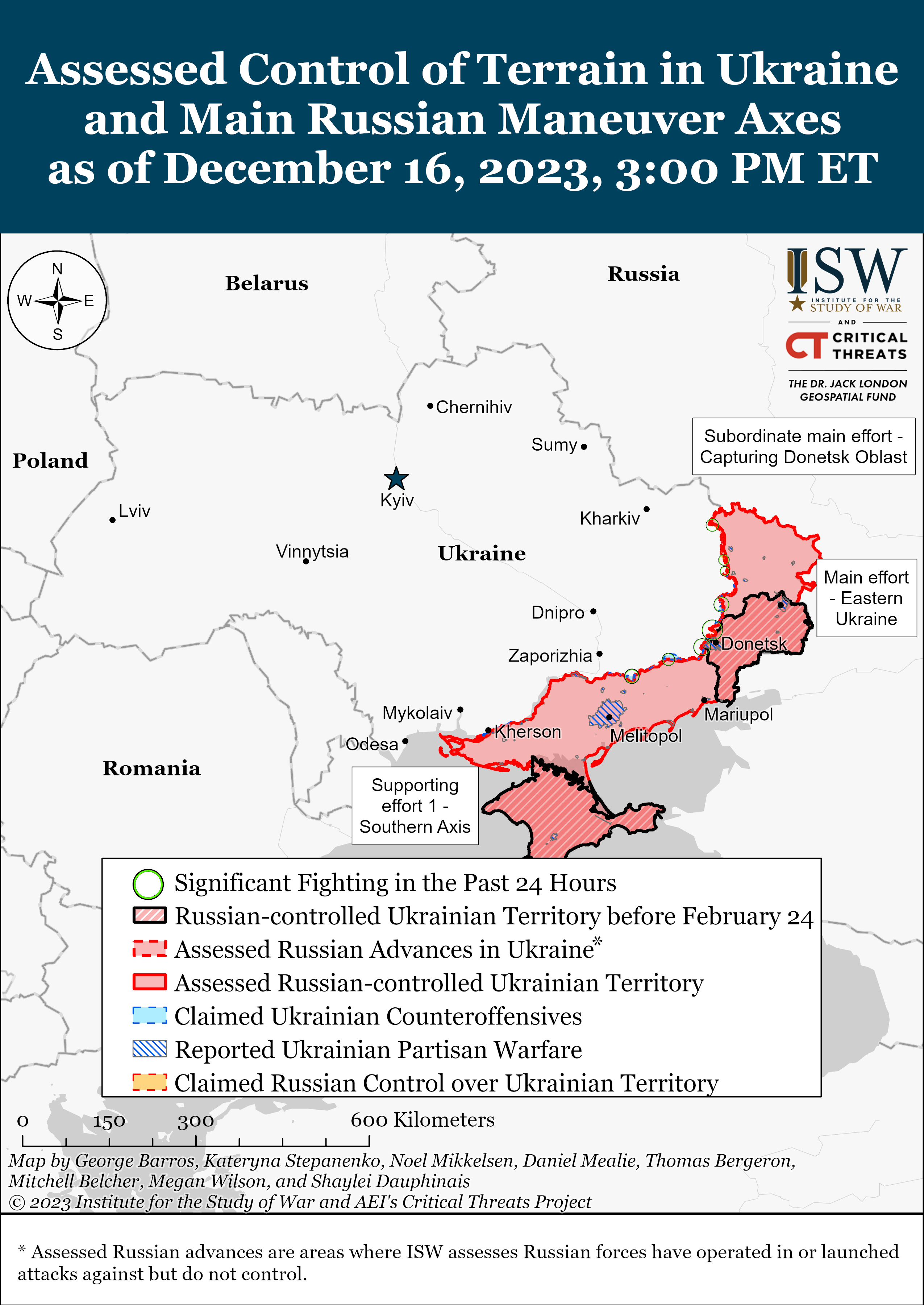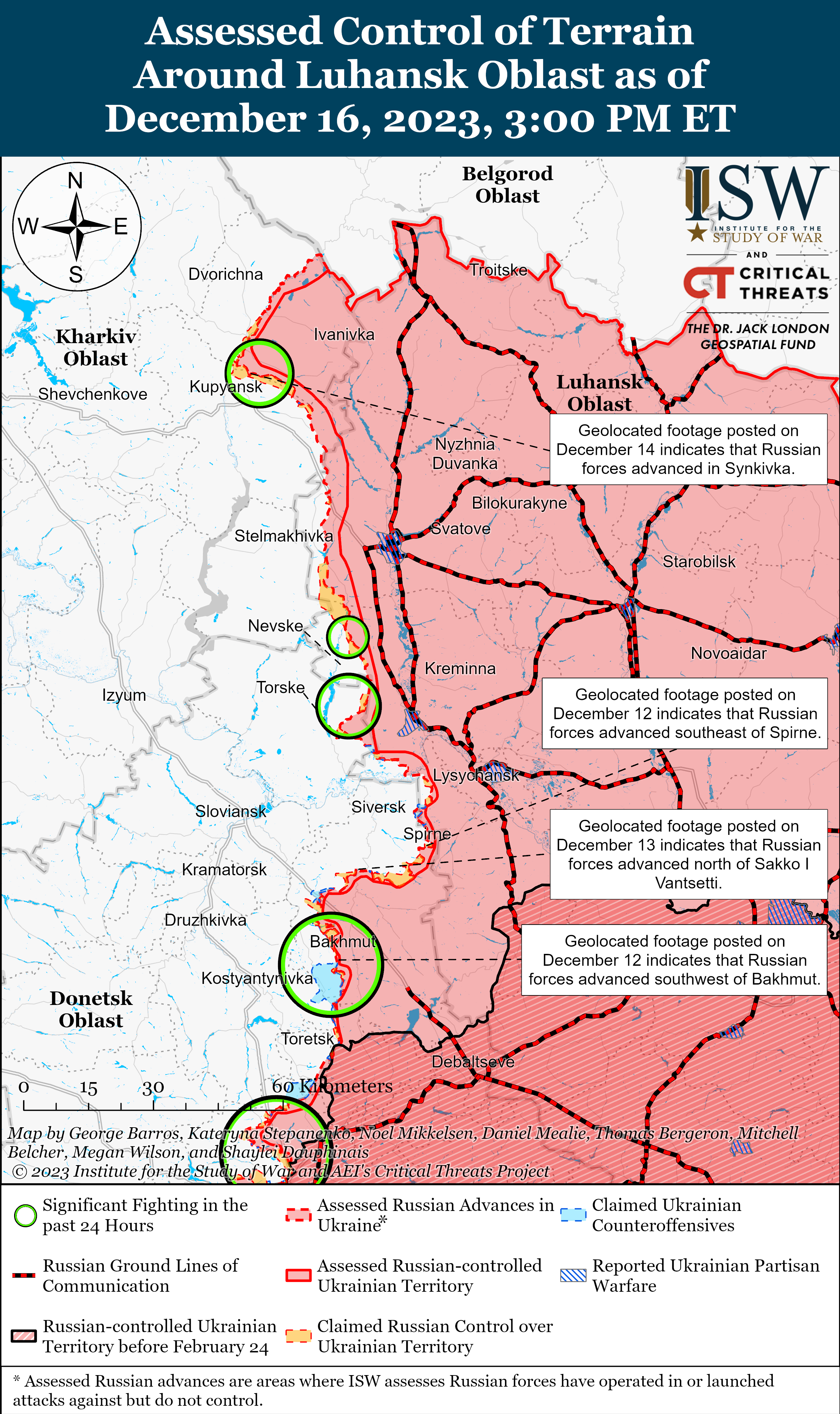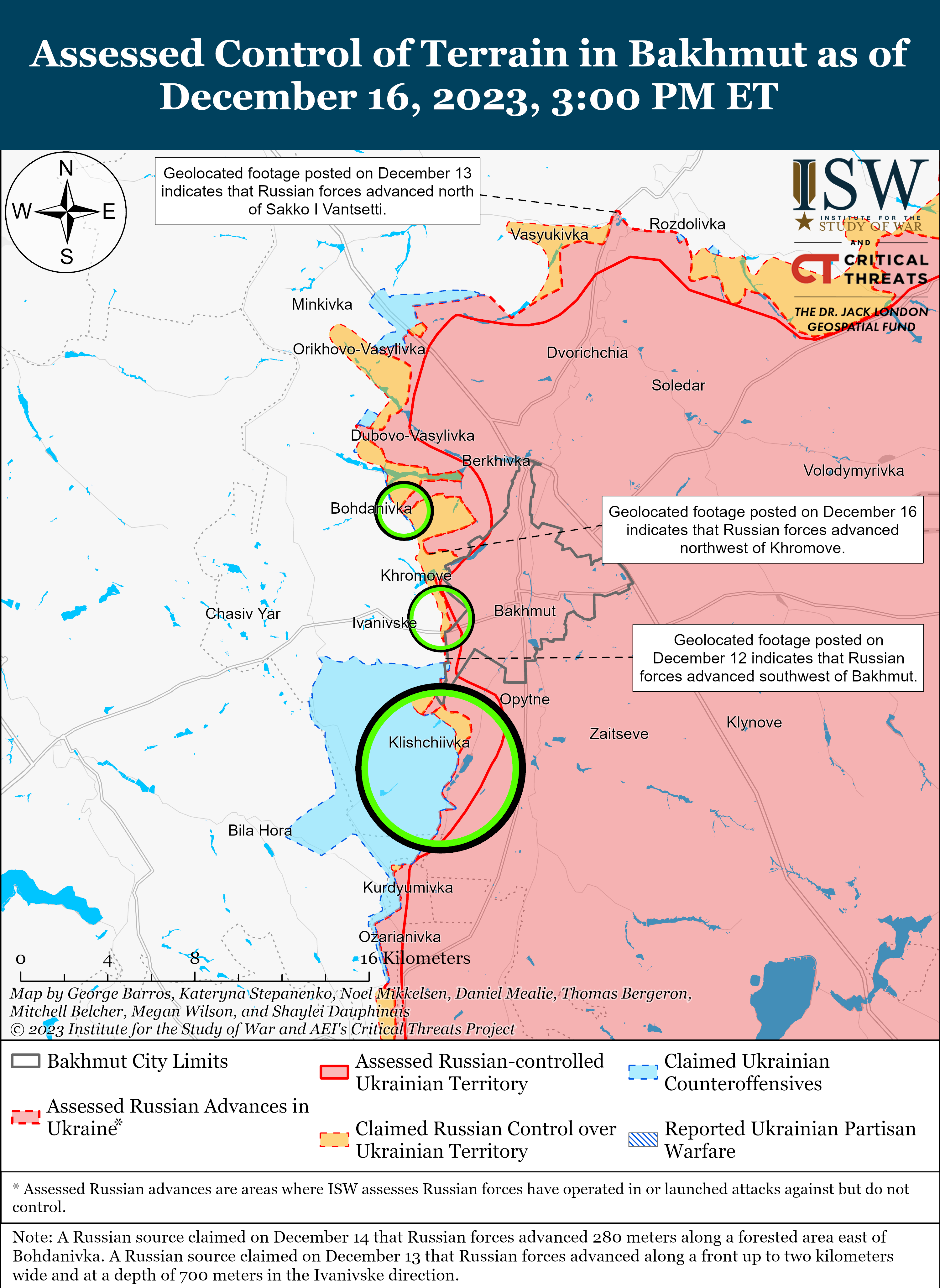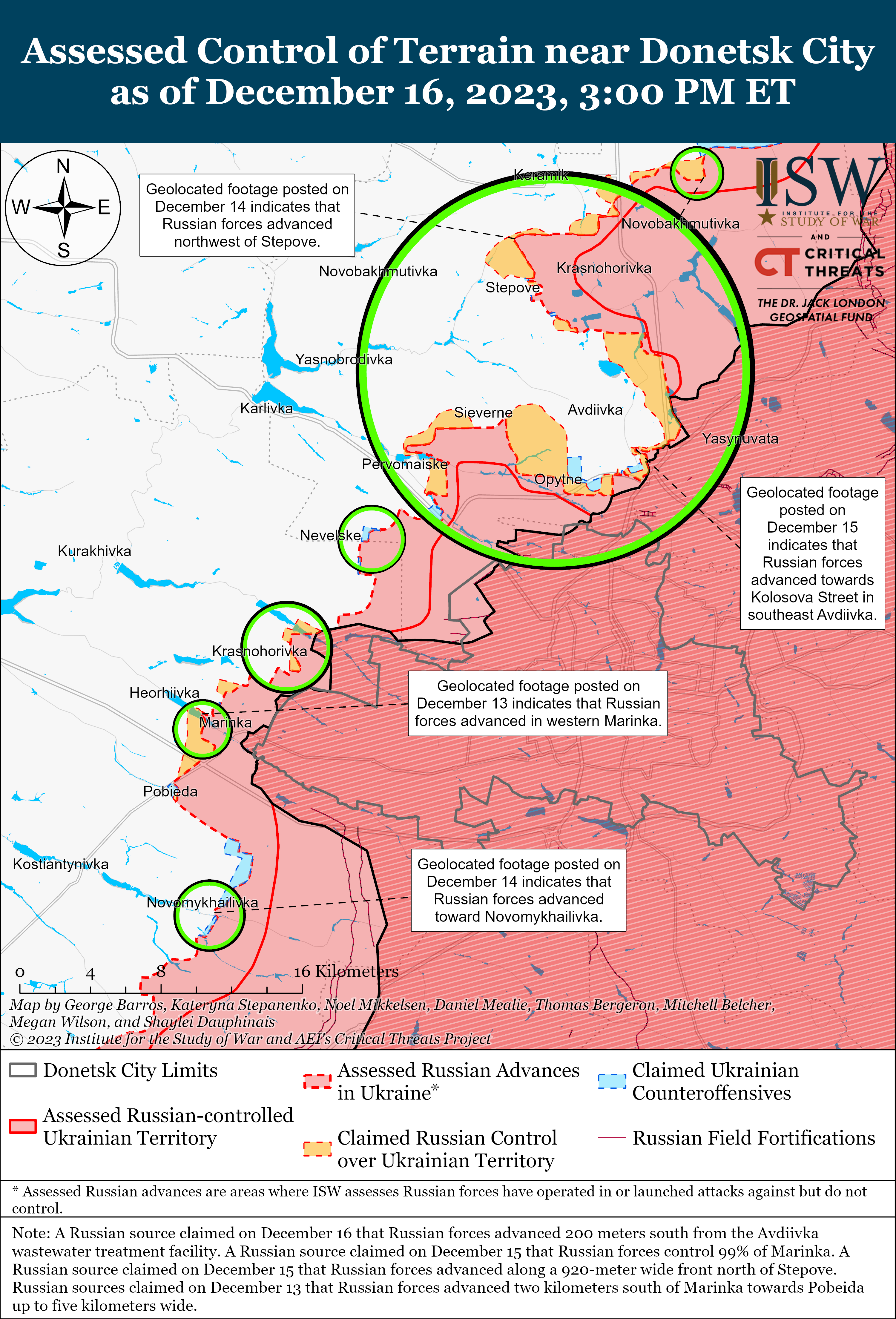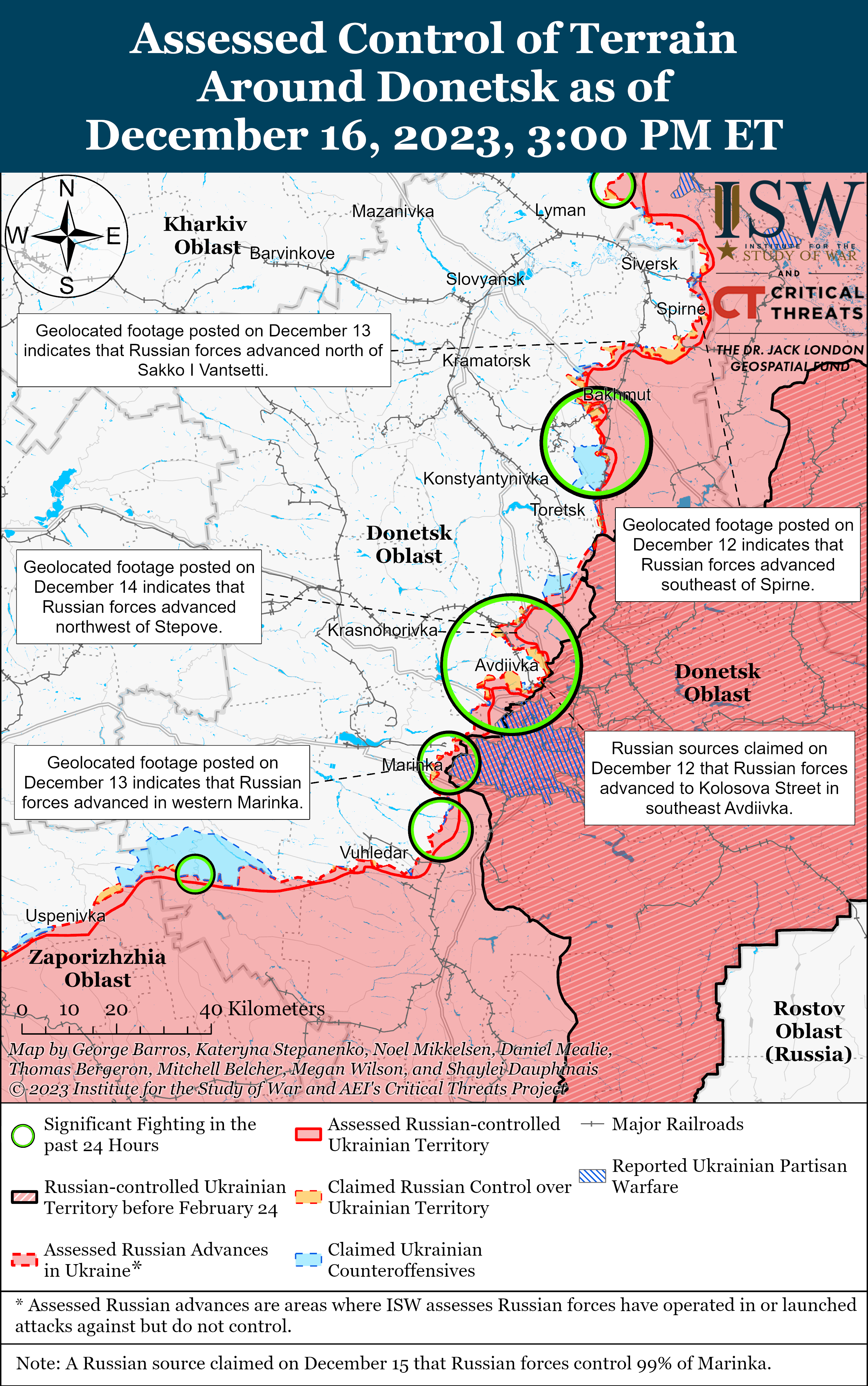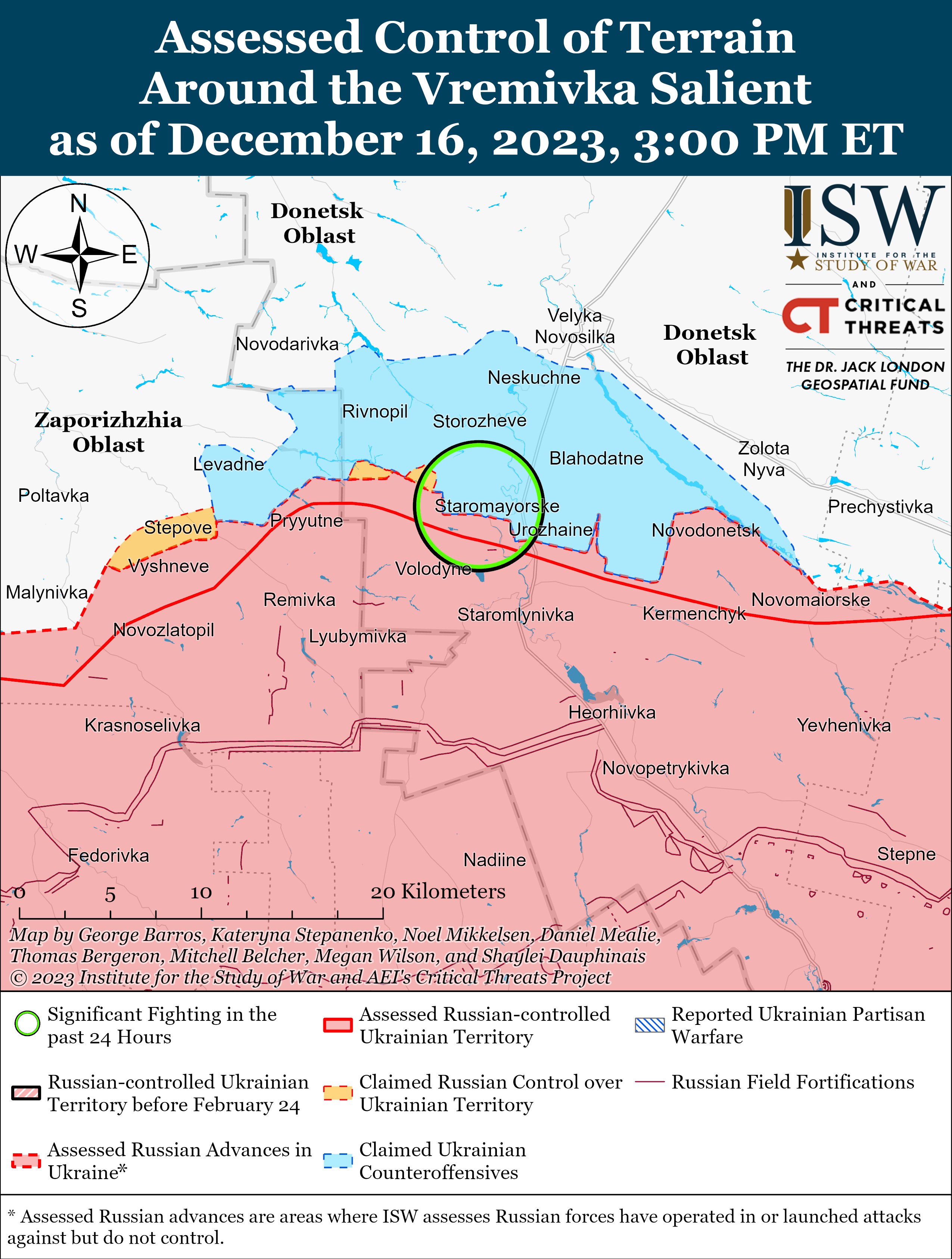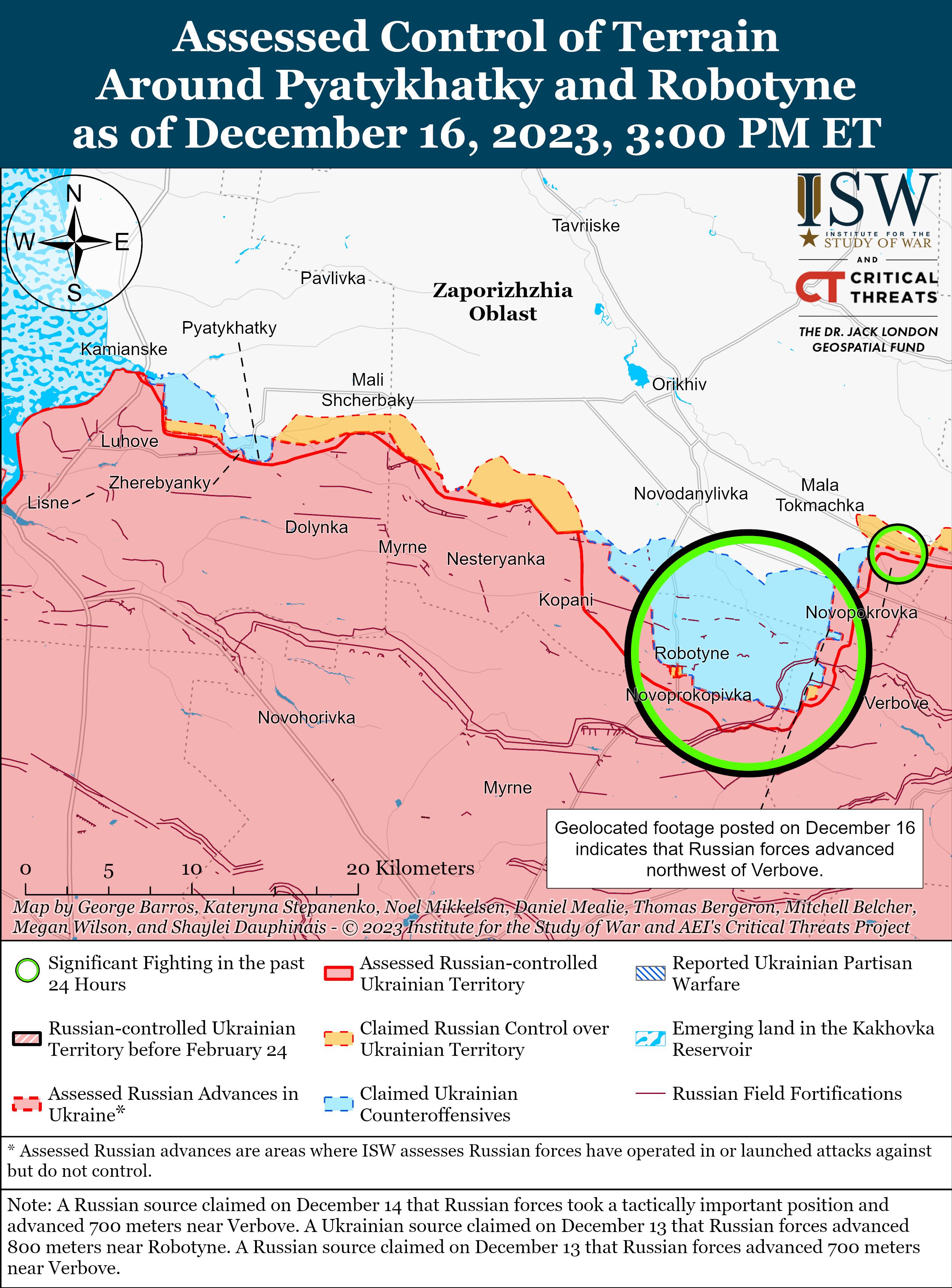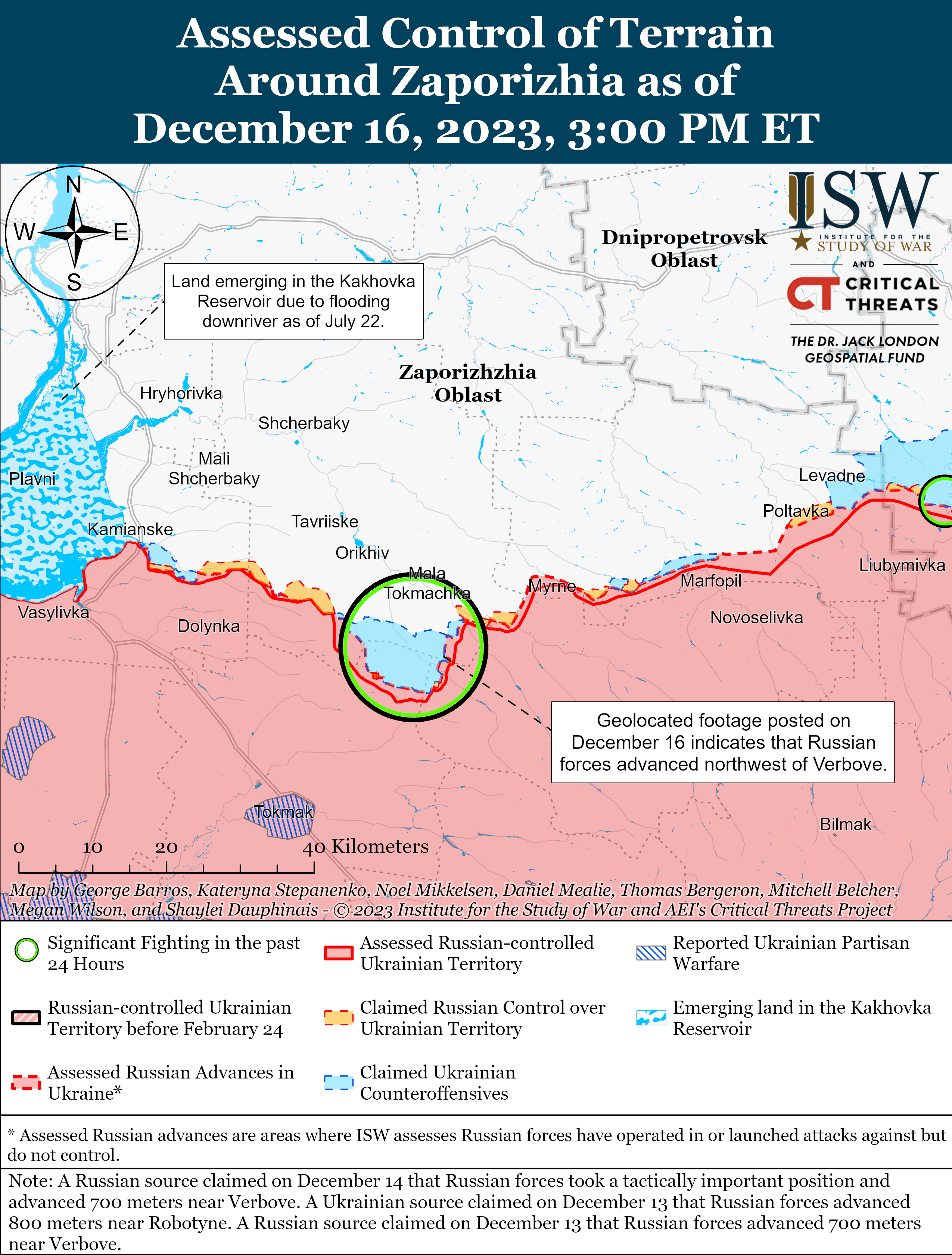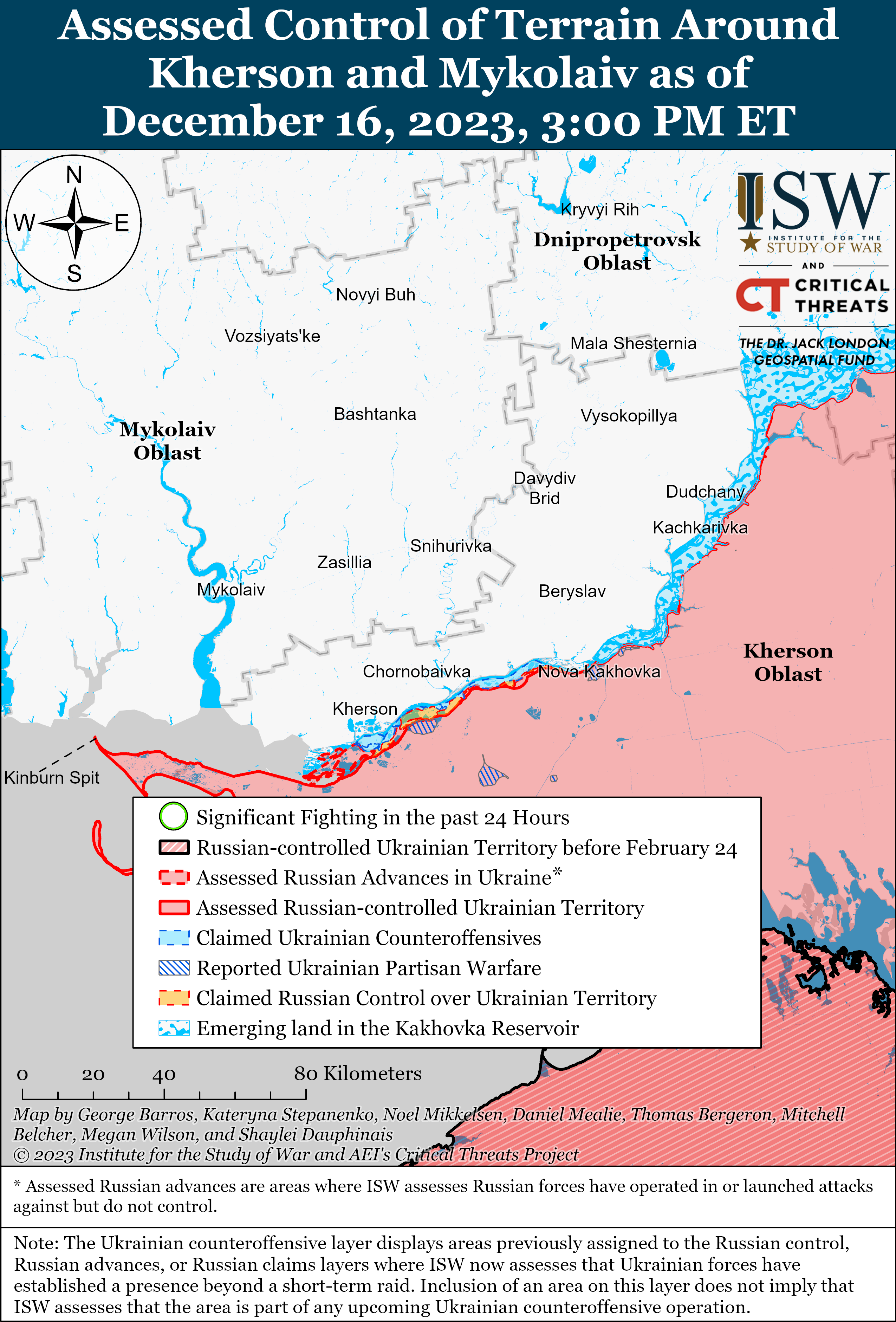Russian Offensive Campaign Assessment, December 16, 2023
Riley Bailey, Kateryna Stepanenko, Christina Harward, Angelica Evans, and Frederick W. Kagan
December 16, 2023, 8:10pm ET
Click here to see ISW’s interactive map of the Russian invasion of Ukraine. This map is updated daily alongside the static maps present in this report.
Click here to see ISW’s 3D control of terrain topographic map of Ukraine. Use of a computer (not a mobile device) is strongly recommended for using this data-heavy tool.
Click here to access ISW’s archive of interactive time-lapse maps of the Russian invasion of Ukraine. These maps complement the static control-of-terrain map that ISW produces daily by showing a dynamic frontline. ISW will update this time-lapse map archive monthly.
Note: The data cut-off for this product was 1:00 pm ET on December 16. ISW will cover subsequent reports in the December 17 Russian Offensive Campaign Assessment.
Ukrainian forces continue operations on the east (left) bank of the Dnipro River in Kherson Oblast amid reported difficult conditions in the area as part of an apparent effort to set conditions for future Ukrainian operations and the resettlement of west (right) bank Kherson Oblast. The New York Times published a series of interviews with Ukrainian military personnel operating on the east bank and along the Dnipro River on December 16, wherein the commander of a Ukrainian regiment stated that Ukrainian drone strikes have heavily suppressed Russian long-range artillery on the east bank in recent months.[1] Ukrainian officials previously stated that Ukrainian forces established several bridgeheads on the east bank as part of an operation that aims to push Russian forces out of artillery range of west bank Kherson Oblast.[2] The reported suppression of long-range Russian artillery may allow Ukrainian forces to operate more freely in near rear areas in west bank Kherson Oblast, which may partially explain intensified Russian glide bomb strikes against Ukrainian targets on the west bank.[3] The much more abundant 152mm tube artillery systems that Russian forces widely operate in Ukraine have an approximate range of 25km, although Russian forces are unlikely to deploy these systems to immediate frontline areas due to the threat of Ukrainian counterbattery fire.
The withdrawal of tube artillery beyond 25km from the west bank and the suppression of long-range Russian artillery would remove consistent threats to populated areas on the west bank and allow the many Ukrainians who fled the Russian occupation of west bank Kherson Oblast to return more safely. The reduction of Russian artillery fire on the west bank would also allow Ukrainian forces to operate more freely along ground lines of communication (GLOCs), deploy more critical counterbattery and air defense systems within the vicinity of the Dnipro River, and more securely launch operations across the Dnipro River. A bridgehead is meant to provide security for crossing forces to continue operations, and the withdrawal of Russian artillery further from the Dnipro River would establish a safer position from which to conduct future operations if the Ukrainian high command so chose.[4]
The Ukrainian commander also reportedly stated that Ukrainian operations on the east bank of the Dnipro River currently aim to draw Russian forces to the area and inflict heavy losses upon them.[5] The Ukrainian commander reportedly added that the effort to draw Russian forces to the area has been successful as the Russian command transferred unspecified Russian Airborne (VDV) elements from western Zaporizhia Oblast to east bank Kherson Oblast.[6] Russian officials have acknowledged that elements of the 7th VDV Division are operating in Kherson Oblast, and it is possible that limited elements of the 7th VDV division operating near Robotyne in western Zaporizhia Oblast (the 247th VDV Regiment, the 108th VDV Regiment, and the 56th VDV Regiment) have redeployed to defend on the east bank, although ISW has observed elements of those units still committed to defending and counterattacking in western Zaporizhia Oblast.[7] Ukrainian military officials previously reported that Ukrainian operations on the east bank between October 17 and November 17 killed 1,126 Russian personnel and wounded 2,217, suggesting that Ukrainian forces may be inflicting significant losses on Russian forces in the area.[8] Russian President Vladimir Putin similarly described Russian defensive operations on the east bank as an intentional attempt to lure and attrit Ukrainian forces, however, and ISW cannot currently assess if there is an asymmetrical attrition gradient in this sector of the front. The degradation of defending Russian forces on east bank Kherson Oblast may be an immediate operational objective, but one that can facilitate the wider stated operational objective of pushing Russian forces out of artillery range of west bank Kherson Oblast.
The New York Times also published interviews with Ukrainian soldiers who have fought on the east bank who described difficult conditions in operating across the Dnipro River and in establishing positions on the east bank.[9] These difficulties are to be expected for what is an economy of force operation with limited positions on a riverbank and may continue until Ukrainian operations set conditions for a more secure Ukrainian bridgehead if the Ukrainian high command chooses to seek to establish one. The expressed Ukrainian objective to push Russian artillery away from the Dnipro River would partially address some of the difficult conditions that Ukrainian personnel described if fully achieved.
Russian President Vladimir Putin’s supporters formally nominated him as an independent candidate for the 2024 presidential elections on December 16, further solidifying Putin’s image as a figure above the Russian political system. The Russian “initiative group of voters” composed of over 500 politicians, actors, athletes, milbloggers, occupation officials, and even a Donetsk People’s Republic’s (DNR) battalion commander, unanimously supported Putin’s decision to run as a self-nominated candidate during the elections.[10] Secretary of the United Russia Party’s General Council Andrey Turchak stated that Putin will be able to establish his election campaign headquarters after completing all procedures for self-nomination – such as registering the initiative group and gathering 300,000 constituents’ signatures – and that the United Russia Party fully supports Putin’s campaign.[11] Russian Prime Minister Mikhail Mishustin also stated that the entire Russian government is “Putin’s team” and that Putin’s decision to run in the presidential elections corresponds to constituencies’ demands.[12] Putin had previously run as an independent candidate in 2018, and ISW’s non-resident Russia fellow Nataliya Bugayova then assessed that Putin creates conditions in which most Russians believe that other Russians support him – an outcome that self-nomination is likely meant to simulate.[13] Bugayova also assessed in 2018 that Putin cares about the perceived legitimacy of the presidential elections, despite the fact that most Russians recognize the regime’s policy failures and the limitations it imposes on their civil liberties. The proclaimed support for Putin of the United Russia Party, other factions, and the government creates the illusion that Putin stands above the Russian political fray and establishes him as a unique figure uniting all of Russia.
Putin also met with faction leaders, Chairman of the Russian State Duma Vyacheslav Volodin, and First Deputy Chief of Staff of the Russian Presidential Administration Sergei Kiriyenko on December 15 to similarly portray himself as above Russian politics.[14] Putin told faction leaders that the presidential election must happen on a competitive basis and called on them to form their positions with a deep understanding of Russian national interests and their responsibility to the Russian public. Putin appears to be positioning himself as a referee able to speak to and guide Russian factions from above even as he nominally “runs” for an office he is certain to win. Putin likely seeks to portray himself as above Russian politics in an effort to distance himself from the controversies of some of these factions and appear as a singular candidate – a role-play that is likely increasingly important to Putin as the veneer of competitive elections in Russia becomes ever thinner.
Russia’s First Deputy Permanent Representative to the United Nations Dmitri Polyanskiy more clearly defined recent statements from high-ranking Russian officials that align with ISW’s long-standing assessment that Russia is unwilling to negotiate with Ukraine in good faith. Polyanskiy stated on December 16 that Ukraine missed its chance to negotiate a “favorable” settlement and that any possible “deal” between Russia and Ukraine would have to entail Ukrainian “capitulation.”[15] Polyanskiy’s statement more clearly explicates Russian Foreign Minister Sergei Lavrov’s statement of December 15, which said the same thing in slightly more coded language.[16] Russian President Vladimir Putin stated on December 14 that Russia’s maximalist objectives in Ukraine – which are tantamount to full Ukrainian and Western surrender – are unchanged.[17]
Putin responded to a question from a French correspondent during Putin’s “Direct Line” forum on December 14 about Putin’s possible plans to speak with French President Emmanuel Macron, stating that he and Macron used to enjoy a good working relationship but that Macron stopped this relationship.[18] Macron stated on December 15 that he would speak to Putin if Putin had any “serious proposals” for establishing peace in Ukraine.[19]
Russian forces launched another series of Shahed-136/131 drone strikes across Ukraine overnight on December 15 to 16. Ukrainian military officials reported that Russian forces launched 31 Shaheds from Bryansk Oblast, Primorsko-Akhtarsk (Krasnodar Krai), and Kursk Oblast and that Ukrainian forces shot down 30 Shaheds over Dnipropetrovsk, Kyiv, Vinnytsia, Chernihiv, Poltava, Cherkasy, Kherson, Zaporizhia, Mykolaiv, and Khmelnytskyi oblasts.[20] Ukraine’s Southern Military Command reported that 12 Shaheds targeted southern Ukraine.[21] Ukrainian Air Force Spokesperson Colonel Yuriy Ihnat stated that Russian forces can launch Shahed drones from a vehicle and that Shahed launchers are mobile.[22] Ihnat added that Russian forces are trying to change Shahed routes by moving them five to 10 kilometers to the left or right to bypass Ukrainian air defenses and reiterated that Ukrainian mobile fire groups are actively destroying Russian drones. Ihnat also observed that Russian forces started launching Shaheds from that Balaklava area (south of Sevastopol) in occupied Crimea – making Balaklava the fifth Russian launching area for Shahed drones.[23]
The Financial Times (FT) reported on December 15 that the G7 may consider using frozen Russian assets to fund Ukraine.[24] FT reported that US officials circulated a discussion paper about how G7 members and other states could seize Russian sovereign assets in a way “consistent with international law” as a “countermeasure to induce Russia to end its aggression” in Ukraine during G7 committee meetings. FT reported that the G7 could use a portion of the $300 billion worth of frozen Russian assets to fund assistance packages to Ukraine and that a US official stated that G7 leaders may discuss the proposal at their meeting in February 2024.
Russian actors continue information operations aimed at discrediting and dividing Ukraine’s military and political leadership, specifically Ukrainian President Volodymyr Zelensky and Commander-in-Chief General Valerii Zaluzhnyi. Ukrainian Defense Minister Rustem Umerov stated on December 16 that Russia is working to discredit Ukraine in the information space by creating artificial conflict within Ukraine’s leadership and a false illusion that Ukraine does not have the support of its Western partners.[25] The Atlantic Council’s Digital Forensic Research Laboratory (DFRLab) and the BBC’s Verify project published a joint report on December 16 that details a Russian information operation that levied corruption accusations against former Ukrainian Defense Minister Oleksii Reznikov ahead of his resignation in September 2023.[26] DFRLab and Verify concluded that Russian actors created thousands of fake accounts aimed at defaming Reznikov and connected the effort to a previous Russian information campaign to discredit Zaluzhnyi in early 2023.[27] ISW has consistently observed Russian actors, including Russian Foreign Intelligence Service (SVR) Director Sergei Naryshkin and Russian Foreign Ministry Spokesperson Maria Zakharova, baselessly claim that high-ranking Western officials intend to “replace” Zelensky and that there is an unspecified conflict between Zelensky and Zaluzhnyi.[28] Russian sources are increasingly promoting reports about internal Ukrainian political tension in an effort to discredit Ukrainian leadership, sow domestic distrust between Ukrainian citizens and the government, and weaken Western support for Ukraine.[29]
A Russian “Storm-Z” assault unit instructor implied that Russian President Vladimir Putin lied about the unregulated status of private military companies (PMCs) during his “Direct Line” forum on December 14 given the state’s significant administrative control over PMCs and other irregular formations.[30] The instructor quoted Putin’s claim that the state cannot account for elements of illegal PMCs fighting in Ukraine because these troops sign contracts directly with the PMCs, which complicates Russia’s ability to grant veteran statuses and provide state benefits. The instructor responded by stating that the Russian State Duma had already adopted a bill in April 2023 that allows the state to recognize all individuals that have fought in Ukraine as veterans, likely implying that the state already has the responsibility to provide veteran statuses to all combatants – even if PMCs are technically illegal.[31] The instructor’s statement was also likely in response to Putin’s concluding observation that Russia might need to adjust the law to account for PMC personnel.[32] The instructor noted that while PMCs, volunteer formations, and other irregular forces may appear as “a whole scattering of some murky and incomprehensible structures,” the Russian Ministry of Defense (MoD) and other Russian institutions account for these troops when they sign contracts or fill out certain questionnaires before being placed in irregular units. The instructor noted that Russia has documentation of most personnel entering volunteer formations under a voluntary contract and that Russian officials improved documentation after they began the formalization campaign in 2023. The instructor further challenged Putin’s claim that most PMC fighters received payments in cash for their service and noted that state structures determine monetary allowances for irregular forces. The instructor observed that the underlying issues are that the Kremlin did not task the MoD officials with ensuring that irregular forces receive their promised benefits, and that the Russian military enlistment system is struggling to account for Russian regular forces not including irregular forces.
The instructor also observed that Russia began to replenish volunteer formations – which operate as irregular forces alongside Russian Armed Forces – with contract servicemen (kontraknik), mobilized personnel, and convicts in 2023.[33] This observation further implies that Russia has notable administrative control over irregular forces, given that mobilized personnel and kontrakniki are part of the Russian Armed Forces and cannot serve in volunteer formations without a directive of the Russian MoD.[34] The Kremlin has to pardon convicts in order for them to serve in volunteer formations. The instructor’s observations not only invalidate Putin’s efforts to distance himself from his decision to expand irregular forces to support his war in Ukraine, but further confirm prior media investigations into the Kremlin’s control of irregular forces.[35] ISW has routinely assessed that Putin’s vast crypto-mobilization campaign that aimed to avoid declaring full-scale mobilization is committing Russia to a long-term financial responsibility – a responsibility that Putin is attempting to downplay.[36]
Key Takeaways:
- Ukrainian forces continue operations on the east (left) bank of the Dnipro River in Kherson Oblast amid reported difficult conditions in the area as part of an apparent effort to set conditions for future Ukrainian operations and the resettlement of west (right) bank Kherson Oblast.
- Russian President Vladimir Putin’s supporters formally nominated him as an independent candidate for the 2024 presidential elections on December 16, further solidifying Putin’s image as a figure above the Russian political system.
- Russia’s First Deputy Permanent Representative to the United Nations Dmitri Polyanskiy more clearly defined recent statements from high-ranking Russian officials that align with ISW’s long-standing assessment that Russia is unwilling to negotiate with Ukraine in good faith.
- Russian forces launched another series of Shahed-136/131 drone strikes across Ukraine overnight on December 15 to 16.
- The Financial Times (FT) reported on December 15 that the G7 may consider using frozen Russian assets to fund Ukraine.
- Russian actors continue information operations aimed at discrediting and dividing Ukraine’s military and political leadership, specifically Ukrainian President Volodymyr Zelensky and Commander-in-Chief General Valerii Zaluzhnyi.
- A Russian “Storm-Z” assault unit instructor implied that Russian President Vladimir Putin lied about the unregulated status of private military companies (PMCs) during his “Direct Line” forum on December 14 given the state’s significant administrative control over PMCs and other irregular formations.
- Russian forces conducted offensive operations along the Kupyansk-Svatove-Kreminna line, near Bakhmut, near Avdiivka, west and southwest of Donetsk City, in the Donetsk-Zaporizhia Oblast border area, and in western Zaporizhia Oblast on December 16 and advanced in some areas.
- A Russian milblogger claimed that Russia will have at least ten Project 22350 Admiral Gorshkov-class frigates in an unspecified time period.
- Ukrainian Mariupol Mayoral Advisor Petro Andryushchenko and the Ukrainian Telegram channel Mariupol Resistance stated on December 16 that Ukrainian partisans recently blew up the car of the commander of an unspecified Russian unit from the North Caucasus in occupied Mariupol.
We do not report in detail on Russian war crimes because these activities are well-covered in Western media and do not directly affect the military operations we are assessing and forecasting. We will continue to evaluate and report on the effects of these criminal activities on the Ukrainian military and the Ukrainian population and specifically on combat in Ukrainian urban areas. We utterly condemn Russian violations of the laws of armed conflict and the Geneva Conventions and crimes against humanity even though we do not describe them in these reports.
- Russian Main Effort – Eastern Ukraine (comprised of two subordinate main efforts)
- Russian Subordinate Main Effort #1 – Capture the remainder of Luhansk Oblast and push westward into eastern Kharkiv Oblast and encircle northern Donetsk Oblast
- Russian Subordinate Main Effort #2 – Capture the entirety of Donetsk Oblast
- Russian Supporting Effort – Southern Axis
- Russian Mobilization and Force Generation Efforts
- Russian Technological Adaptations
- Activities in Russian-occupied areas
- Russian Information Operations and Narratives
Russian Main Effort – Eastern Ukraine
Russian Subordinate Main Effort #1 – Luhansk Oblast (Russian objective: Capture the remainder of Luhansk Oblast and push westward into eastern Kharkiv Oblast and northern Donetsk Oblast)
Russian forces continued offensive operations along the Kupyansk-Svatove-Kreminna line on December 16 but did not make confirmed advances. The Ukrainian General Staff reported that Ukrainian forces repelled at least 11 Russian attacks near Synkivka (9km east of Kupyansk) and at least five attacks near Makiivka (23km northwest of Kreminna) and east of Terny (15km west of Kreminna) and Yampolivka (17km west of Kreminna).[37] A Kremlin-affiliated milblogger claimed on December 15 that Russian forces also attacked along the Zahoruykivka-Tymkivka-Ivanivka-Kyslivka line (16km east to 20km southeast of Kupyansk).[38] The spokesperson for a Ukrainian brigade operating in the Kupyansk direction stated on December 16 that Russian forces began using more effective unspecified loitering munitions instead of Lancet drones in the Kupyansk and Lyman directions.[39]
Russian sources claimed that Ukrainian forces unsuccessfully attacked along the Kupyansk-Svatove-Kreminna line on December 16. The Russian Ministry of Defense (MoD) claimed that Russian forces repelled Ukrainian attacks in the Kupyansk direction near Vilshana (15km northeast of Kupyansk), Synkivka, Lake Lyman (just north of Synkivka), Petropavlivka (7km east of Kupyansk), and Novoselivske (14km northwest of Svatove) and in the Lyman direction near Terny, Zhytlivka (2km northwest of Kreminna), Kuzmyne (3km southwest of Kreminna), and Bilohorivka (10km south of Kreminna).[40] A prominent Russian milblogger claimed that fighting occurred near the Serebryanske forest area (10km southwest of Kreminna).[41]
Russian Subordinate Main Effort #2 – Donetsk Oblast (Russian objective: Capture the entirety of Donetsk Oblast, the claimed territory of Russia’s proxies in Donbas)
The Russian Ministry of Defense (MoD) claimed that Ukrainian forces unsuccessfully attacked near Bakhmut near Ivanivske (6km west of Bakhmut) and Klishchiivka (7km southwest of Bakhmut) on December 16.[42]
Russian forces conducted localized offensive operations near Bakhmut on December 16 and recently made a confirmed advance. Geolocated footage published on December 16 indicates that Russian forces advanced north of Khromove (immediately west of Bakhmut).[43] The Ukrainian General Staff reported that Russian forces unsuccessfully attacked near Bohdanivka (6km northwest of Bakhmut), Ivanivske, Klishchiivka, and Andriivka (10km southwest of Bakhmut).[44] Russian milbloggers claimed that Russian forces also unsuccessfully attacked from Khromove.[45] Russian milbloggers continued to characterize the localized Russian offensive effort around Bakhmut as an operation aimed at advancing to Chasiv Yar (12km west of Bakhmut).[46] The Russian MoD reported that elements of the Russian 200th Motorized Rifle Brigade (Northern Fleet) are operating in the Bakhmut direction and that elements of the Russian 98th Airborne (VDV) Division are operating north of Bakhmut.[47] Chechen Head Ramzan Kadyrov claimed that elements of the Akhmat Spetsnaz “Shustry” detachment are operating on the outskirts of Klishchiivka.[48]
Russian forces conducted offensive operations near Avdiivka on December 16 and recently made a confirmed advance. Geolocated footage published on December 15 indicates that Russian forces advanced to the western outskirts of the industrial zone southeast of Avdiivka.[49] Russian milbloggers claimed on December 15 and 16 that Russian forces advanced west of the railway north of Stepove (3km northwest of Avdiivka) and in the industrial zone.[50] A Russian milblogger, amplifying alleged unspecified Ukrainian military observers, claimed on December 16 that Russian forces advanced along a front one kilometer wide north of Stepove, advanced 200 meters in depth south of the waste treatment plant south of Krasnohorivka (5km northwest of Avdiivka), and advanced along a front 540 meters wide to a depth of 350 meters in the industrial zone.[51] A Russian source claimed that Russian forces marginally advanced near Berdychi (5km northwest of Avdiivka).[52] The Ukrainian General Staff reported that Russian forces unsuccessfully attacked east of Novobakhmutivka (9km northwest of Avdiivka), Stepove, and Avdiivka and south of Sieverne (6km west of Avdiivka) and Pervomaiske (10km southwest of Avdiivka).[53]
Frontelligence Insight, led by a Ukrainian reserve officer, reported on December 15 that satellite imagery from October 10 to November 28 indicates that Russian forces lost over 211 vehicles near Avdiivka.[54] Frontelligence Insight reported that over 50 percent of Russia’s vehicle losses happened in the first three weeks of the Russian effort to capture Avdiivka. Frontelligence Insight’s findings largely corroborate previous reports of Russian vehicle losses and support ISW’s assessment that Russian forces largely shifted from mechanized to mass infantry-led assaults near Avdiivka in order to conserve armored vehicles following the first two waves of assaults on the settlement.[55]
Russian sources claimed that Ukrainian forces unsuccessfully attacked west and southwest of Donetsk City on December 16. The Russian MoD claimed that Ukrainian forces unsuccessfully attacked near Marinka (on the western outskirts of Donetsk City) and Pobieda (5km southwest of Donetsk City).[56] A Russian milblogger claimed that elements of the Russian 5th Motorized Rifle Brigade (1st Donetsk People’s Republic [DNR] Army Corps) repelled a Ukrainian attack in the Marinka direction.[57]
Russian forces conducted offensive operations west and southwest of Donetsk City but did not make any confirmed advances on December 16. Russian sources claimed on December 15 and 16 that Russian forces advanced near Nevelske (directly west of Donetsk City), towards Pobieda and Novomykhailivka (10km southwest of Donetsk City), on the northwestern outskirts of Marinka, and on the southeastern outskirts of Novomykhailivka.[58] One Russian milblogger claimed that Russian forces completely control Marinka, but another milblogger claimed that Ukrainian forces still control a marginal part of the settlement.[59] The Ukrainian General Staff reported that Russian forces unsuccessfully attacked near Marinka, Nevelske, Krasnohorivka (directly west of Donetsk City), Pobieda, and Novomykhailivka.[60] A Russian milblogger claimed that Ukrainian minefields and fortifications are preventing Russian forces from advancing to Novomykhailivka.[61] Russian sources claimed that elements of the Russian 20th Motorized Rifle Division (8th CAA, Southern Military District) are operating near Marinka and between Pobieda and Novomykhailivka.[62]
Russian Supporting Effort – Southern Axis (Russian objective: Maintain frontline positions and secure rear areas against Ukrainian strikes)
The Ukrainian General Staff reported that Ukrainian forces repelled two Russian assaults near Staromayorske (9km south of Velyka Novosilka) in the Donetsk-Zaporizhia Oblast border area on December 16.[63]
Ukrainian forces continued counteroffensive operations near Robotyne in western Zaporizhia oblast on December 16 but did not make any confirmed advances. Russian sources, including the Russian Ministry of Defense (MoD), claimed that Russian forces repelled Ukrainian assaults near Robotyne and Verbove (9km east of Robotyne).[64]
Russian forces continued counterattacks in western Zaporizhia Oblast on December 16 and recently made confirmed marginal gains. Geolocated footage published on December 15 indicates that Russian forces recently made marginal gains northwest of Verbove.[65] Russian milbloggers claimed that Russian forces recaptured positions north of Verbove on December 13 and consolidated control over positions west of Robotyne that Russian forces captured on December 15.[66] A Russian milblogger amplified footage on December 16 purporting to show elements of the Russian 247th Airborne (VDV) Regiment (7th VDV Division) capturing Ukrainian positions north of Verbove.[67] The Ukrainian General Staff reported that Ukrainian forces repelled at least eight Russian assaults west of Novopokrovka (13km northeast of Robotyne) and south of Robotyne.[68]
Ukrainian forces continued ground operations in east (left) bank Kherson Oblast on December 16. Russian milbloggers claimed that Ukrainian forces attempted to advance towards forest areas near Krynky (30km northeast of Kherson City and 2km from the Dnipro River) on December 15 and 16 and that heavy battles are ongoing in the area.[69] A Russian milblogger claimed that Russian forces continued to strike Ukrainian positions near the Antonivsky railway bridge north of Poyma (15km east of Kherson City and 4km from the Dnipro River) on December 16.[70]
Russian sources claimed that Ukrainian forces conducted strikes targeting rear Russian areas in southern Ukraine and occupied Crimea on December 15 and 16. Russian sources claimed on December 16 that Russian forces intercepted up to 15 Ukrainian HIMARS rockets and S-200 missiles targeting Henichesk (170km southeast of Kherson City) and Nova Mayachka (45km southeast of Kherson City) in occupied Kherson Oblast and Dzhankoi, occupied Crimea (90km northeast of Simferopol).[71] Kherson Oblast occupation administration head Vladimir Saldo claimed that a Ukrainian HIMARS rocket struck Russian military personnel near Nova Mayachka.[72] The Russian MoD claimed that Russian air defenses and electronic warfare (EW) complexes downed all 32 drones that Ukrainian forces launched at Russian targets in occupied Crimea on December 15.[73] Russian sources amplified footage on December 15 of Russian air defenses activating between Chernomorske (125km northwest of Simferopol) and Mizhvodne (120km northwest of Simferopol).[74] Ukrainian Southern Operational Command Spokesperson Captain First Rank Nataliya Humenyuk stated that Ukrainian forces have degraded Russian air defense coverage over occupied Crimea and that Russian forces must constantly maneuver air defense systems to provide coverage while protecting the systems from Ukrainian strikes.[75]
Russian Mobilization and Force Generation Efforts (Russian objective: Expand combat power without conducting general mobilization)
A Russian milblogger claimed that Russia will have at least ten Project 22350 Admiral Gorshkov-class frigates in an unspecified time period.[76] The milblogger added that former Commander of the Russian Baltic Fleet and current chief adviser to the head of the Russian United Shipbuilding Corporation (USC) Admiral Viktor Chirkov previously stated that the Russian navy needs at least 18 frigates.[77] The milblogger claimed that the Admiral Gorshkov-class Admiral Kasatonov frigate can carry 16 hypersonic 3M22 “Tsirkon” missiles, making it the second surface combat ship in the world with “hypersonic” capacities after the Russian Admiral Gorshkov-class Admiral Gorshkov lead ship. Russian President Vladimir Putin inspected the Admiral Kasatonov frigate at the Sevmash plant on December 11.[78] The milblogger added that the third frigate of Project 22350, the Admiral Golovko frigate, will raise the Russian navy flag by the end of 2023 and will be able to use “hypersonic weapons” in 2024. The milblogger also claimed that the Russian Amur Shipyard received a license to build Admiral Gorshkov-class frigates.
A Russian milblogger claimed that the Military Transport Aviation Command of the Russian Aerospace Forces conducted a tactical flight exercise with the crews of the An-124-100 “Ruslan” military transport aircraft, during which seven aircraft simultaneously launched into the air.[79] The purpose of the tactical flight exercise was to test the training of young crews of the An-124-100 Ruslan in the simultaneous transfer of military units with standard weapons and equipment over long distances.
Russian Technological Adaptations (Russian objective: Introduce technological innovations to optimize systems for use in Ukraine)
A Russian milblogger claimed on December 16 that Russian truck and engine manufacturer Kamaz created a prototype of the Russian surface drone “Oduvanchik” (Dandelion).[80] The milblogger claimed that Russian developers are promising that the “Oduvanchik” drone will have a speed of 80 kilometers per hour and a payload of 600 kilograms.
A Ukrainian military official stated on December 16 that Russian and Ukrainian forces are currently competing in a technological race for the development of drones. Ukrainian spokesperson for the 3rd Assault Brigade Oleksandr Borodin stated that Russian forces have an advantage in the number of drones, while Ukrainian forces have an advantage in the ability to make company-level decision-making that allows them to quickly update drones.[81]
Activities in Russian-occupied areas (Russian objective: Consolidate administrative control of annexed areas; forcibly integrate Ukrainian citizens into Russian sociocultural, economic, military, and governance systems)
Ukrainian Mariupol Mayoral Advisor Petro Andryushchenko and the Ukrainian Telegram channel Mariupol Resistance stated on December 16 that Ukrainian partisans recently blew up the car of the commander of an unspecified Russian unit from the North Caucasus in occupied Mariupol.[82] The Ukrainian partisan attack reportedly hospitalized the Russian commander, whose condition is unknown.[83]
Ukrainian officials continue efforts to return deported children to Ukraine while Russian officials attempt to downplay their coordinated deportation campaign in occupied Ukraine. Ukrainian Verkhnova Rada Human Rights Ombudsman Dmytro Lubinets announced on December 16 that three deported Ukrainian children reunited with their families as a part of the Qatari-mediated program to return Ukrainian children from Russia.[84] Kremlin-appointed Children’s Rights Commissioner Maria Lvova-Belova claimed that Russian authorities have helped reunite 48 Ukrainian children from 35 families.[85] Lvova-Belova added that this number does not include children who arrived at health resorts in Russia with parental agreement but whose parents did not retrieve them ”in time” in fall 2022.[86] ISW has long assessed that Russian officials, particularly Lvova-Belova, have organized various vacation and medical schemes to facilitate the deportation of Ukrainian children from occupied territories to Russia.[87]
Russian Information Operations and Narratives
Russian information space actors are attempting to portray Russian forces’ treatment of Ukrainian prisoners of war (POWs) as humane. Russian state media and milbloggers claimed on December 16 that Russian forces captured six Ukrainian border guards in the Kursk Oblast border area and emphasized Russian authorities’ humane treatment of the Ukrainian POWs.[88]
Russian authorities appear to be launching a concerted campaign to improve Russia’s deteriorating relationship with Armenia likely in response to concerns about Russia’s waning influence in the South Caucasus and may be enlisting prominent Russian milbloggers to follow suit. Kremlin newswire TASS reported on December 15 that Russian Deputy Foreign Affairs Minister Mikhail Galuzin stated that ”difficulties” in Russia’s relationship with Armenia can be overcome, especially when considering the long-term economic, cultural, humanitarian, and political ties between the two states.[89] Russian Deputy Prime Minister Alexey Overchuk and Armenian Deputy Prime Minister Mher Grigoryan met on December 15 to discuss the importance of expanding ”constructive bilateral ties” between Russia and Armenia.[90] The Rybar Telegram channel founder, Mikhail Zvinchuk, stated in an interview with Armenian outlet Alpha News on December 16 that Armenia is the “most successful project in cultivating Russophobia” and that the crisis in the Russian-Armenian relationship is “man-made” and the “fruit of outside intervention.”[91] Zvinchuk accused the US of cultivating Russophobia in Armenia but noted that the relationship can still be restored if Russian and Armenian officials make ”strong-willed decisions.” Zvinchuk’s Rybar channel has previously blamed Armenian Prime Minister Nikol Pashinyan for Armenia’s pivot away from Russian security structures and for the perceived Russophobia in Armenian society.[92] Zvinchuk, who has numerous ties to the Kremlin, may be floating the idea of reconciliation within a Russian information space increasingly hostile towards Armenia on behalf of the Kremlin.[93]
A Russian occupation official echoed Russian President Vladimir Putin’s demands for the “demilitarization” and complete capitulation of Ukraine. Kherson Oblast occupation administration head Vladimir Saldo stated in an interview with Russian state outlet RIA Novosti on December 16 that any future peace negotiations with Ukraine will be on Russia’s terms, which include “complete capitulation of Ukraine, the demilitarization of Ukraine, and the return of all original Russian territories and their inhabitants who want to return to Russia.”[94] Saldo’s statement is another confirmation of ISW’s assessment that Russia does not intend to engage in good faith peace negotiations with Ukraine.[95]
Significant activity in Belarus (Russian efforts to increase its military presence in Belarus and further integrate Belarus into Russian-favorable frameworks and Wagner Group activity in Belarus)
Nothing significant to report.
Note: ISW does not receive any classified material from any source, uses only publicly available information, and draws extensively on Russian, Ukrainian, and Western reporting and social media as well as commercially available satellite imagery and other geospatial data as the basis for these reports. References to all sources used are provided in the endnotes of each update.
[23] https://suspilne dot media/640912-rosiani-pocali-zapuskati-udarni-bezpilotniki-sahed-z-novogo-majdancika-u-krimu-so-vidomo/
[25] https://suspilne dot media/640930-rosia-namagaetsa-stvoriti-stucnij-konflikt-vseredini-kerivnictva-ukraini-umerov/
[39] https://suspiln dot media/640760-rosiani-pocali-vikoristovuvati-samopalnu-zaminu-lancetam-aka-dovoli-efektivna-dibrov/
[75] https://suspilne dot media/640892-u-silah-oboroni-pivdna-prokomentuvali-nicnu-ataku-droniv-na-okupovanij-krim/
[81] https://suspilne dot media/640800-v-nih-perevaga-v-kilkosti-v-nas-u-svidkosti-risen-3-brigada-pro-virobnictvo-bpla/


